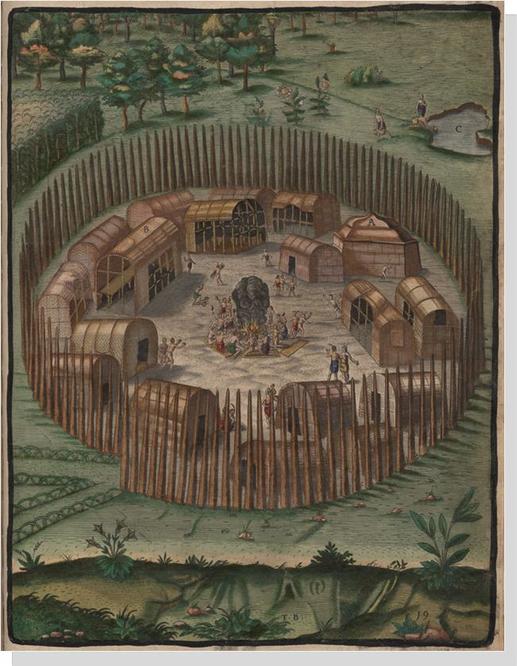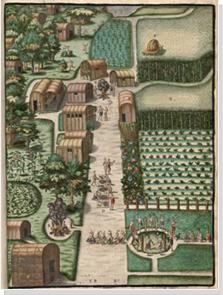
VIEW ON NATURE
The Original Natural Foods
By: Stephen Wendt
 Nat·u·ral food…noun….......Food that has undergone minimal processing and contains no preservatives or artificial additives. Well if there was ever natural foods, just look at the diet of the pre-colonial Native Americans in Virginia, the First Virginians. For millennia, they were nomadic hunters/ gatherers who principally relied on the meat of large megafauna (mastodons, mammoths, musk oxen, and giant ground sloths). But due to overhunting and climate change, they adapted to a more balanced plant / animal diet of seasonal fruits, berries, nuts, fishes, shellfish, birds, fowl, deer, bears, and smaller mammals.
Nat·u·ral food…noun….......Food that has undergone minimal processing and contains no preservatives or artificial additives. Well if there was ever natural foods, just look at the diet of the pre-colonial Native Americans in Virginia, the First Virginians. For millennia, they were nomadic hunters/ gatherers who principally relied on the meat of large megafauna (mastodons, mammoths, musk oxen, and giant ground sloths). But due to overhunting and climate change, they adapted to a more balanced plant / animal diet of seasonal fruits, berries, nuts, fishes, shellfish, birds, fowl, deer, bears, and smaller mammals.
But in faraway lands, other indigenous peoples in Mexico and South and Central Americas were selectively converting wild species of grasses and other plants. These included the earliest corn (9,000 years ago), quinoa, and later, crops of beans, squashes and pumpkins that eventually made their way into the Mississippi and Ohio River Valleys, and 500 years later, into Virginia.
By the time the English began their occupation in 1607 at Jamestown, about 50,000 First Virginias lived here. The Powhatan Chiefdom alone numbering ~15,000 people reliant on gathered and home-grown natural foods. The Jamestown diaries spoke of natives planting corn, beans, squashes, pumpkins, and fruits in residential plots and fertile river floodplains, and seasonally gathering, fishing, and hunting numerous natural foods.
Their crops were quite prolific because of their tenders’ cultivation practices of planting three sister crops-- corn, bean, and squashes-- all together. This synergy generated maximum production while prolonging soil fertility and backbreaking tree clearing of new fields. The climbing beans thrived up on the sunlit cornstalks, the squash vine blankets choked out the weeds, and the soil kept rich (because the beans converted the nitrogen from air into the soil as a fertilizer).
Diverse food preparation practices were used. Meats were roasted and grains and tubers were pounded into ashcakes and baked. Dumplings made from wild grains were common. But once ceramic pots were developed ~1000 AD, the Indians could boil liquids and create near-constant brewing family stews more akin to hunter/ gatherer lifestyle without set meal times.
Captain John Smith wrote that Indian bread made of cornmeal was preferred over bread made of wild tubers (tuckahoe). Venison and bear meat were prized, as was "nut-milk" made from walnuts and other nuts. Corn, was their premier crop, eaten many ways and at all stages of ripeness. Green cornstalks and ears were sucked for their sweet juice; ripe ears were shucked, dried, and ground into me al and flour, or boiled into hominy; and colored-kernel ears were roasted in hot ashes.
al and flour, or boiled into hominy; and colored-kernel ears were roasted in hot ashes.
Jamestown colonist Ralph Hamor’s 1614 diary described a Chief Powhatan’s offering of “a great bowl of boiled peas and beans” at dawn and “as much bread as might have sufficed a dozen hungry men," then boiled fresh fish and roasted oysters and crabs, followed later by “three fat does and a buck and two great cock turkeys…with supper ended, scarce a bone to be seen."
Ralph Hamor—a Jamestown colonist and the author of A True Discourse of the Present State of Virginia (1615)—remarked that the dumplings served to him in 1614 were particularly large, probably about the size of modern-day tennis balls. Even the grouts, or hard pieces left after pounding out flour, were used; Indians cleaned them of husk pieces in a sieve and then boiled them several hours into a thickened pottage called ushuccohomen or pounded corn, which is the origin of the tribal name Chickahominy. The thriftiest women went even further: they beat dried corncobs into powder (called pungnough by the Powhatans) in order to stretch their cornmeal supply.
Oh, to dream of all those foods without a trace of trans fats, cholesterol, pesticides, antibiotics and more! Those were the days when people were one with Nature in Virginia.
(Copyright © 2012 Annandale Chamber of Commerce. All rights reserved. No reproduction of this article, in whole or in part is permitted without the consent of The ENDEAVOR News Magazine. (Photographs & images, on this page, and on this website, are not available for use by other publications, blogs, individuals, websites, or social media sites.)
Copyright 2012 Annandale Chamber of Commerce. All rights reserved. Privacy Policy

